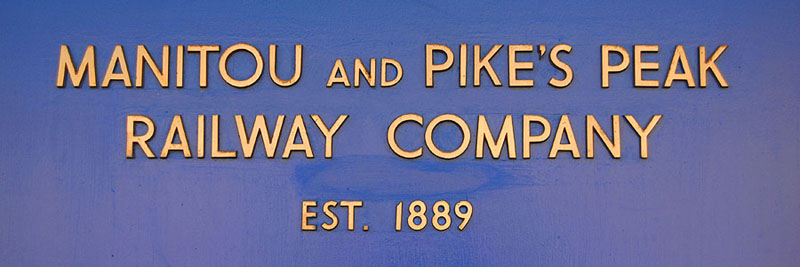
Manitou Springs, CO, USA - August 2013
Located in the picturesque town of Manitou Springs, the cog railroad is the perfect way to reach the summit. The other way is by driving the famous Pike's Peak highway. Construction on the cog railroad began in 1889 and reached the peak in 1891.

(Trevor McTavish)

Here we see the station in Manitou Springs. It was only about 9:00am when our train left but the early trains book up fast because they reach the peak before the weather does. (Trevor McTavish)

Because of the unique 25% grade the railroad the trains rely on a third cog track. The conventional rails support the weight of the railcars while the cog track is where the traction actually occurs. (Trevor McTavish)

Of course, when your equipment dates back at least a half century, it's easy to find some rust for an artistic shot. (Trevor McTavish)

Once seated in your assigned seats, the train begins its climb, initially passing through some forested areas. Not that I have problems with pre-written scripts, but I really don't need to hear the nicknames of every boulder and bush on the route. (Trevor McTavish)

The extreme grades feel steep inside the car, but if you actually look sideways, you'll realize just how extreme a 25% grade can be. (Trevor McTavish)

Unfortunately much of the route below the tree line is obscured by the towering trees, many of which encroach on the rail line, which doesn't fear them as they would had they still been employing fire belching steam locomotives. (Trevor McTavish)

As the train approaches the tree line, some gaps open in the view allowing passengers to see down the valley to Colorado Springs. (Trevor McTavish)

Obviously, once the tree line has been reached, the view opens up and you can see for miles - provided you're sitting on the outer seats. The view from the cramped middle seats is non-existent. (Trevor McTavish)

At the "Weathertop" location there's a siding that allows the ascending trains to wait for the descending trains. Apparently when the original stone building was built at this location it was destroyed over the winter by constant 50 and 60 mile-per-hour winds. (Trevor McTavish)

Ascending from Weathertop to the summit, which is just on the far side of the visible peak. (Trevor McTavish)

You can still see the remains of the original wagon and hiking trail. Although its unused today, mother nature is slow in reclaiming the route as vegetation only grows about three inches per century at this altitude. (Trevor McTavish)

Again, once above the tree line, the view is quite impressive. At this stage of the trip its possible to notice the effects of the thin air. (Trevor McTavish)

Among the items pointed out by our tour guide as this point were a gold mine that has (to date) produced more than $3-billion. (Trevor McTavish)

This area is also the only area where you'll see the other train. The "modern" railcars in use today were actually built in Switzerland and delivered between 1964 and 1989. The single railcar I rode in was a 1960s-vintage example, while the articulated one that followed (shown) dated from the 1980s. (Trevor McTavish)

I snapped another shot to show just how extreme the steep grade becomes just before the summit. (Trevor McTavish)

Thankfully one benefit of the cog system is that you can stop on a dime. I appreciated that since there was a 10,000 foot drop at the end of those tracks. (Trevor McTavish)

See, I wasn't kidding. (Trevor McTavish)

At 14,100 feet you're well above the elevation in which small airplanes require oxygen. The rules state that you're only allowed one hour of flying between 10,500 and 12,500 feet without supplemental oxygen. Here on the mountain - you're on your own. (Trevor McTavish)

On a clear day the view from 14,000 feet is phenomenal. Apparently you can see as far as the western edge of Kansas. In July 1893, school teacher Katharine Lee Bates joined some friends on a hike and returned home to combine her impressions with those from her railroad trip to Colorado. The poem she penned became America the beautiful. (Trevor McTavish)

(Trevor McTavish)

Ours was only the second train of the day (9:00am departure), but by the time we'd reached the peak, the weather was already starting to close in. Apparently there have been people killed by lightning, and its easy to see why - you're actually inside the clouds when they move in. In fact, as we were boarding the trains, the clouds closed in and you couldn't see the summit station from the trains - about 50 feet away. (Trevor McTavish)

There are several viewing areas near the station, as well as the parking lot for those who chose to drive. It took us about 90 minutes to reach the peak, and the highway normally takes about two hours. The record set for racing up the highway was a mind blowing eight minutes! (Trevor McTavish)

In truly American style, what do you put on the peak of a mountain that inspired one of the most patriotic songs in American history? That's right - a hot dog stand and gift shop. I was surprised how many people were content to spend their limited time eating and shopping instead of sightseeing. (Trevor McTavish)

Heading back down the mountain we were assured the trains couldn't run away because they were equipped with two braking systems. (Trevor McTavish)

Failing that, we were also told that the State of Colorado had also put two big springs at the end of the rail line - Manitou Springs and Colorado Springs. See, I told you they liked corny jokes on this trip. All in all, it was quite the experience and something I would recommend to anyone in the area. (Trevor McTavish)